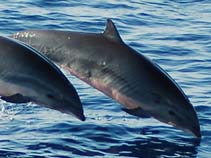| Family: |
Delphinidae (marine or true dolphins) |
| Max. size: |
270 cm TL (male/unsexed); max.weight: 210 kg |
| Environment: |
pelagic; marine; depth range 0 - 3793 m, oceanodromous |
| Distribution: |
Atlantic Ocean and Indo-Pacific. |
| Diagnosis: |
Robust. Short beak, subtriangular to weakly falcate dorsal fin, pointed flippers, and relatively small concave flukes. Dark bluish to brownish-gray dorsal cape, pale gray flank, and white to pinkish belly. Wide dark gray to black stripe extending from the eye to the anus, conspicuously set off by thin pale cream-colored borders. |
| Biology: |
Pantropical distribution. Dolphins are directly caught for use as shark-bait in Sta. Ana and Aparri, Philippines (Ref. 77119). Minimum depth from Ref. 116169. Often seen near shore, along the outer continental shelf and in deep oceanic waters (Ref. 80620). Feeds in deep waterse (Ref. 122680). Feeds on mid-water fish, squid and crustaceans (Ref. 1394). Forms large social groups (Ref. 122680). Occasionally sighted with melon-headed whales, Peponocephala electra. (Ref. 80612). |
| IUCN Red List Status: |
(LC); Date assessed: 22 February 2018 Ref. 123251)
|
| Threat to humans: |
|
| Country info: |
|
Source and more info: www.sealifebase.org. For personal, classroom, and other internal use only. Not for publication.

